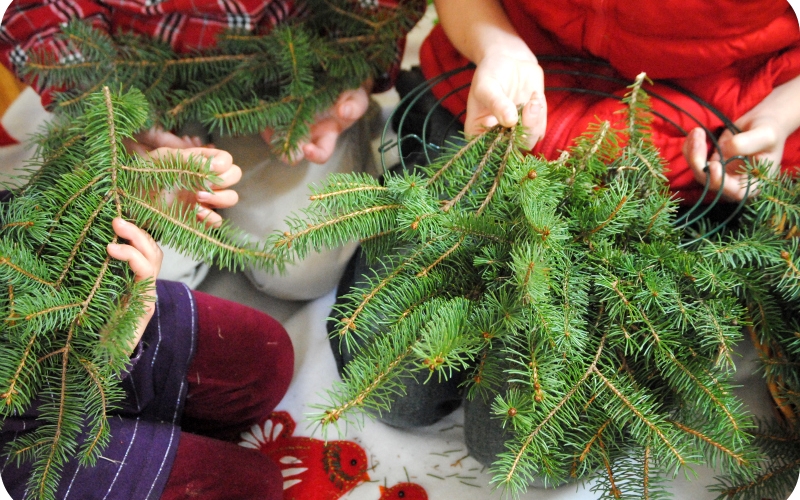The seasonal celebrations of old were far from ‘far-out’. They were about celebrating the passing of the seasons and recognising the farming calendar. The rise of industrial farming and mass production of food separated us from the natural world around us. Yet it is clear that there is a desire to return to these ways, with ‘foraging’ and ‘natural’ becoming buzz words. We know instinctively that we should be connecting with the earth but where do we start? The more time we spend in nature and learning from her, the more comfortable we’ll feel. Finding local herb walks, fungi forays, talks and workshops is the best way to learn to recognise different plants and mushrooms. Arming yourself with several good field guides and a sketch book and making your own nature diary is an excellent way to build up a harmonious relationship with your locality too. In this way we can offer our children the great gift of growing up feeling comfortable in, and knowledgeable about, the natural environment around them.
What is the winter solstice?
The winter solstice is when the earth’s tilt is at the maximum point away from the sun and marks the shortest day and longest night of the year. It is traditionally called Yuletide. This year in the northern hemisphere winter solstice falls on Thursday 22nd December. It is the moment ‘between’ – the point between death and rebirth – and represents as yet hidden potential. Life will start to draw upwards again from this point forward so winter solstice is about celebrating the birth of new life.
Witching, picking, connecting, celebrating…recognise this special time by bringing in symbols of life and blood (such as holly berries). Warm your cockles for the coming year with passion and heartfelt warmth and give thanks for the riches past. The past, the future and the present are all held in the moment of the solstice.
This ancient pagan celebration is now widely known as Christmas and still offers us a great opportunity to connect with our families and communities and to celebrate each other’s company. At the winter solstice or Christmas we naturally and subconsciously embrace herbs and spices – in mulled wine, pomades, wreaths, even bringing whole trees into our houses! What great medicine for the soul. All these sensory delights protect and nourish us.
How to get witchy with your kids this Christmas
The only way to really start believing in the herbs and develop the confidence to use them is to go out and spend time with them. Research them, pick them, enliven all your senses and intuition and see what happens when you spend a day studying them with your family. The knowledge of old is still there, held by the plants themselves. We just need to ask and they will open their secret world for us to explore. Start with the plants you know: holly, pine and ivy are great ones to explore at Christmas time.
Nature’s winter characters
Get to know each plant by drawing it in detail. Just like people, each plant has a different personality so we need to introduce ourselves and get to know them. What does it the plant look like? Who does it look like? What personality traits lurk inside? Get the children to name the plants to help them remember them and draw pictures of the characters they invent. Observation and imagination are key here. Gather the herbs, turn them into beautiful wreaths and adorn your homes. Make up stories as you harvest and illustrate them when you get home. Bringing children up with the idea that witchcraft is alive and very real delights them. Herb-craft isn’t just for fairy horror stories, it’s for getting involved with, enjoying and for bringing to life.
Rituals with herbs
I think I’ve always had ritual in my life, collecting things from places I love and putting them in a special place to give thanks. As I got older, I became more conscious of what I was doing and these days I find herbs, stones, shells or anything around to represent the season and the elements. This feels like a good foundation – recognising air for communication and ideas, fire for passion and drive, water for the ability to flow with the current and respond emotionally, and earth for staying grounded and keeping it real. My fellow witch, Karen and I felt that there were so many weird associations around ritual, that having kids around helps to keep it really fresh and freeform. Let things flow according to the season, the moon and the people who are around.
Nature area
Creating a seasonal nature area is a great way to celebrate the passing of time throughout the year. Things that you find when you’re out and about can be brought in to the home and displayed. You can use them for props in stories or simply enjoy how beautiful they look displayed in your home.
Gathering
What you’ll need: snippers, gardening gloves and a lovely open-topped basket
Go out into the woods, park, or along the canal or riverbank and see what you can find…
What is still growing and looking vibrant after the onslaught of early winter? Pine, ivy, holly (you might need your gloves for this one!) and is there any mistletoe within reach? Because they are still thriving in the depths of winter, collecting some of the fresh sprigs and bringing them into our homes adds a sense of vibrancy to our lives. Doing a bit of research into the different trees can add depth to the stories you have been creating.
Scots Pine
Large bonfires of scots pine were traditionally lit to welcome back or draw up the sunshine. Our favourite cartoon toadstool, the fly agaric, grows beneath scots pine. Some say that Santa Claus with his fluffy white beard and red suit has his origins in the shamans of Siberia whose visions after eating fly agaric took them flying on reindeer. Take time to connect with the tree which provides nourishment for such a fantastical mushroom.
Ivy
Our common Ivy, Hedera helix is not the poison ivy of the Americas. It is generally only used externally or for magical purposes but it is said that by gently boiling a handful of the bruised leaves in wine some of its toxicity will be removed. Ivy flowers during the long winter months and is an important source of pollen for the bees. It is thus known to promote fertility and is recommended to be carried by women wanting to conceive. Ivy also represents fidelity and is still used today in hand fastenings to bind folk together in matrimony.
Holly
The holly king rules the earth from the summer solstice (mid-summer) to the winter solstice (mid-winter). He shares the yearly power with his nemesis and twin, the oak king. They battle for the goddess each year and the defeated god retires for the following six months to nurse his wounds. The holly king is robust and jolly but fiercely protective so honouring the holly at this time could enable courage and protection in the coming months. Holly leaves have been used as a diaphoretic (promoting perspiration) and as a diuretic. Holly is great for helping things to shift at what can be a sluggish time of year making it a perfect solstice herb to invite into our homes.
Thank Mother Nature
After you’ve given thanks to the trees for providing, you can use your foraged plants to make a wreath (an old coat hanger bent out and some garden twine will do the trick), or place some on your mantle piece or nature table. Left over seeds from autumn, sweet chestnuts, interesting stones and especially any foliage you find will add to your solstice nature area and you can add to it as the days go on.
Light a candle nearby and, with your kids, write down all the things you’ve enjoyed about the last year. You can then talk about what you’d like to happen next year. Place some protective holly around these thanks and dreams. You can leave this there until you remove your seasonal decorations. I like to burn the wish list at this point to send it out there, but if that’s not possible the kids can tear it up into really small bits before it goes in the compost or recycling.
Even when nature seems foreboding with freezing temperatures and deep snow, spending time outdoors can be hugely rewarding and bringing home a harvest of green delights even more so. Happy witching!
Beautiful image for this piece taken from http://gardenmama.typepad.com/my_weblog/2010/12/into-the-woods.html







